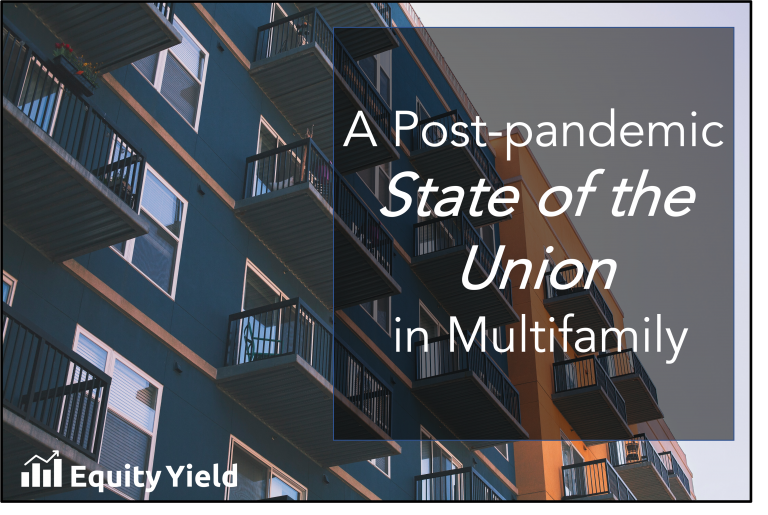
As the dust settles, we are beginning to see the impacts of covid-19 on the multifamily industry.
At the onset of the pandemic, myself and many other real estate investors were prepared for a real estate crash and some deep discount buying. For a brief moment the market held its breath, waiting for the fire sale, but the crash never happened. Then asset prices stared to rise as institutions and private investors alike begin buying multifamily real estate like never before. Suffice to say the market did not respond as we initially expected, but in retrospect the reaction all makes sense.
The last ten year period has shown unprecedented prosperity with low inflation, a tight labor market, and solid investment yield across most asset classes. Over the last ten years, investors have made huge gains on their portfolios, and the pandemic acted as a catalyst for many of these investors to rebalance their portfolios and shift capital towards real estate.
Historically real estate has always been a safe haven for investors. Its’ consistent cashflow, predictable appreciation over time, and tax advantages make this asset classic inherently good at preserving capital and building wealth. With hospitality and office space experiencing low tenancy due to the pandemic lockdown, the natural choice for investors in these asset classes became multifamily. With asset prices and rents soaring across country, many investors are looking across the terrain of the multifamily industry through a hazy cloud left by the pandemic and asking, “where are we now, and what’s next?”.
As Professional real estate investors we have been monitoring every report and piece of data we can get our hands on in order to put our own market observations into context, and there is a shinning beacon of light at the end of the tunnel. Overall, the multifamily industry is strong and healthy with no signs that growth will be diminishing any time soon. I wanted to take some time to discuss some interesting and unexpected impacts of the pandemic as well as some challenges we expect to see in the future.
Observations of the Changing Multifamily Landscape
Absorption and delivery – One of the unexpected results of the pandemic was an impact on the new delivery pipeline in strong growing markets. These markets have historically seen a solid number of new deliveries, as developers try to keep pace with an ever-growing population and demand for housing in these markets.
At the onset of the pandemic, developers and lenders began to hold their breath, waiting for the other shoe to drop. Many new development projects were paused or cancelled. This knocked down the supply of new units to markets that already had a huge lack of available housing. As the pandemic marched on, we saw an uptick in in-bound migration to the South-East as people no longer tied to a desk took the pandemic as an opportunity to make the move to locations such as Florida, The Carolinas, and Georgia.
This perfect storm of constraining supply and growing demand, fueled by in-bound migration, set the stage for an unprecedented upward trend in rent growth. Some of these markets are now so tight that they are projecting 0% vacancy in the next 12 to 18 months.
We happen to own assets in one of these growth markets. The Sarasota-Bradenton-North Port MSA has been one of the top growing markets and top moving destination in the U.S. for a number of years now and has seen effective rent growth over the last 12 months of 18.9%. We have seen cap rates compress from 5% to 4% in the last 12 months. The assets we own here are 99% occupied. Although the MSA has always had strong fundamentals of population growth, median income growth, and economic diversity the cap rate environment has not been reflective of other similarly strong markets until now. The pandemic has acted as a catalyst, moving cap rates and asset prices in the market to be in line with other comparable growth markets. As market fundamentals not only remain strong but continue to improve, we expect this trend to continue.
Rents in many growth markets are rising far above expectations from the supply and demand dynamic caused by the pandemic, but this is not the only factor driving rent growth. At the onset of the pandemic normal rent increases on lease renewals stopped, and many value-add properties undergoing renovations paused their renovation programs as investors waited to see how the market would react to such an unprecedented event.
This pause in normal rent appreciation left a vacuum of rent growth, and as we make our way out of the pandemic, we are seeing growing rents rushing to fill this void. Some savvy value-add investors who paused renovations early on have been keenly watching asset prices soar and have decided to sell their assets without completing their planned renovations. This not only increases their ROI (by reducing the capital basis and lowering the senior note principal), but this has also created an opportunity for new investors to acquire assets with more upside than you would typically see on a value-add deal, further pushing up prices that new investors are willing to pay for these assets.
Coming credit-check challenges
The eviction moratorium and loan forbearance has come to an end, and while our portfolio has largely been unaffected by the wave of past due rents and pending evictions, there are many investors and tenants who were greatly impacted by the pandemic.
Unemployment has yet to stabilize, and many of the rental assistance programs are winding down. What comes next is a credit-check crunch that will be an ongoing challenge for landlords and tenants alike. There will be a wave of evictions as landlords work to restabilize their properties. This will put a huge amount prospective tenants with now questionable credit history into the market, further increasing demand pressure and adding fuel to the rent growth trend.
However, having an eviction on a tenant’s record will make passing future credit-checks much more difficult. Further complicating matters for landlords is the fact that there will be a number of prospective tenants who will have avoided an eviction because they made settlement agreements or accepted a cash-for-key incentive from their previous landlord. There is also the moral dilemma – many of the tenants facing and recovering from eviction are good people who would have otherwise paid their rent if it weren’t for the impact of the pandemic. Going forward, I expect to see minor changes in the credit-check and approval procedures for landlords. A couple of the programs we implement on our properties to manage these challenges are third-party deposit insurance, and approval with guarantor policies.
Our third-party deposit insurance allows tenants to avoid the traditional security deposit of anywhere from $850 to $1300 at the time of move in. This amount of money is hard to come by for someone starting a new job and just getting back on their feet. Instead, we offer the tenant an insurance product which costs them $21/month and provides the landlord with coverage for loss of rent and damages to the unit.
As tenants get back on their feet and begin to rebuild their credit, we are now looking at credit application differently and doing our best to put their credit history into context. If the tenant has an otherwise good credit history, and has a story that makes sense, demonstrates a willingness to move forward and rebuild their credit, and they seem to be an all-around good person, we are now allowing approval of application with a guarantor. The guarantor must pass our credit-check and agree to cover any delinquencies of the tenant. This process allows the tenant to rebuild credit and secure a new place to live, while giving landlords piece of mind.
Macroeconomic forces at play
Beside the coming credit-check crunch and wave of evictions, we also expect to see some fallout from macroeconomic forces at work throughout the pandemic.
The Fed’s “easy money policy” is another huge factor in the multifamily market that has had a direct impact on asset prices and presents a challenge for investors in the future. In order to maintain liquidity in the market and avoid a massive correction at the onset of the pandemic, the federal reserve took emergency evasive action and implemented a number of “easy money policies” to help to prop up the system.
Among these was a drop of interest rates, and the printing of $6 trillion dollars. The massive influx of cheap and accessible capital has been one of the driving factors behind growing asset prices. Investors purchasing real estate are able to leverage their purchases with cheaper debt which yield higher cashflow and greater return on investment. This has allowed investors to make increasingly higher offers in an already competitive market. To add fuel to the fire, this is now compounded by a large number of investors looking to hedge against inflation by purchasing real estate.
Due to the inherent lower risk nature of real estate, investing using debt to lever an investment has always been and will always be a key part of an effective real estate investment strategy. However, given that rates are now hovering around zero it is important that investors take into consideration debt market conditions in which they they will be selling these assets in future. The debt available for future real estate transactions will be one of the determining factors of prices in the future – as interest rates come back up to normalized levels, future transactions will no longer have the same leveraging advantages that investors today may have.
Now more than ever it is important for investors to give a lot of thought into the exit strategy. Who will you sell to? What will they be able to pay you? And will it make sense for both parties involved in the transaction?
The reversion analysis that we undertake on our own acquisitions involves more than just cap rate escalations. We also conduct a deep dive into sales comparisons, rent comps, rent growth trends, and the driving market forces behind them. We seek out to make the distinction between asset value driven by inexpensive debt and asset value driven by true supply and demand dynamics present in the submarket.
By ensuring we are buying quality assets whose value is driven by sustainable market growth, we can protect against future asset price decline that may be triggered by rising interest rates in the near future.
A positive outlook for the right assets with the right operators
Overall, the outlook on multifamily assets is very good. Multifamily real estate still provides investors with preservation of capital, cashflow, appreciation over time, and excellent tax benefits.
Although the fundamentals of some markets have shifted with changes in employment and migration trends, the old rules still apply. Markets with population growth, job growth, diverse economies, net absorption, good rent to income ratios, and landlord friendly policies have done very well through the pandemic, and it looks as though we are just at the beginning of the growth trend in these markets.
Now more than ever it is vitally important to invest in quality assets located in strong and growing markets, to be sure that assets have value supported by a strong market and a quality well located property. It is equally important, to invest with experienced operators that have proactively managed through the pandemic and that have a finger on the pulse of changes that are happening in the industry.

